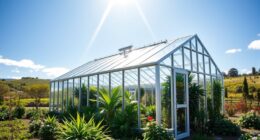To create a sustainable backyard oasis, focus on rainwater harvesting, native plants, and eco-friendly practices. Install rain barrels or larger collection systems to reduce dependence on municipal water and support garden irrigation. Choose native plants that need less water and minimal chemicals, promoting biodiversity. Design zones for composting, mulching, and permeable pathways to improve soil health and manage water runoff. Keep exploring options to make your yard both beautiful and environmentally sustainable.
Key Takeaways
- Incorporate rainwater harvesting systems like rain barrels and collection setups to conserve water and reduce utility bills.
- Use native plants suited to your region to minimize water, fertilizer, and pesticide needs.
- Design garden zones that promote composting, mulching, and permeable surfaces for optimal soil health and water management.
- Add wildlife-friendly features such as small ponds, butterfly gardens, and native plant clusters to support biodiversity.
- Choose eco-friendly materials for pathways, furniture, and accessories to enhance sustainability and aesthetic appeal.

Have you ever wondered how to create a backyard that’s both beautiful and eco-friendly? One of the most effective ways to achieve this is by integrating sustainable practices into your garden design. Start by considering rainwater harvesting, which allows you to collect and use natural water runoff instead of relying solely on municipal supplies. Installing rain barrels or a more extensive rainwater collection system helps you reduce water bills and conserves a precious resource. When you harvest rainwater, you can use it to irrigate your plants, helping them thrive while lowering your environmental footprint. Combining rainwater harvesting with thoughtful native plant selection creates a resilient, low-maintenance garden that supports local ecosystems.
Create an eco-friendly backyard with rainwater harvesting and native plants for a sustainable, low-maintenance garden.
Choosing native plants is vital because they are naturally adapted to your area’s climate, soil, and rainfall patterns. These plants require less water, fewer fertilizers, and minimal pesticides, making them an ideal choice for an eco-friendly backyard. By selecting native species, you also promote biodiversity, providing habitat and food for local pollinators like bees and butterflies. When planning your garden, research which plants thrive in your region and incorporate a variety of flowering plants, shrubs, and trees to ensure year-round interest and support for wildlife. Native plants often grow more robustly with less intervention, saving you time, effort, and resources. Additionally, spiritual practices such as mindful gardening can deepen your connection to nature and enhance your overall well-being. Incorporating aesthetic wall organization ideas into your garden design can create functional and visually appealing spaces that support your sustainability goals.
In addition to rainwater harvesting and native plant selection, think about creating zones within your yard that promote sustainability. For example, designate an area for composting kitchen scraps and garden waste. Compost enriches your soil naturally, reducing the need for chemical fertilizers. Mulching around your plants helps retain moisture, suppress weeds, and improve soil health. Incorporating permeable pathways made from gravel, wood chips, or other natural materials allows rainwater to soak into the ground instead of running off, further supporting your rainwater harvesting efforts. Implementing permeable surfaces not only benefits water management but also adds visual texture to your landscape. Properly maintained compost bins can also help reduce waste and enhance soil fertility, making your garden more productive and sustainable. Utilizing efficient water management techniques can further optimize resource use and ensure your garden remains vibrant during dry periods.
Designing your backyard with eco-friendly principles doesn’t mean sacrificing beauty. You can create a lush, inviting space that’s also sustainable. Use native plants as focal points and plant them in clusters for visual impact. Add features like a small pond or a butterfly garden to attract wildlife. Use recycled or biodegradable materials for garden accessories and furniture. With a little planning, your backyard can become a haven that not only looks stunning but also promotes environmental health. By embracing rainwater harvesting, native plant selection, and other sustainable practices, you’ll enjoy a garden that’s both beautiful and beneficial for generations to come.
Frequently Asked Questions
How Can I Attract Native Wildlife to My Eco-Friendly Garden?
To attract native wildlife, focus on native plant selection, which provides essential food and shelter. Enhance your wildlife habitat by adding birdhouses, water sources, and native flowering plants. Avoid chemicals and pesticides that can harm animals. Keep some natural areas undisturbed to encourage nesting and foraging. Your efforts will create a welcoming environment, encouraging local birds, insects, and small mammals to thrive in your eco-friendly garden.
What Are Cost-Effective Sustainable Materials for Backyard Landscaping?
When choosing cost-effective sustainable materials for your backyard, opt for recycled materials like reclaimed wood or metal, which cut costs and reduce waste. Natural stone is another great option; it’s durable, looks fantastic, and requires minimal maintenance. These materials not only save you money but also support eco-friendly practices, helping you create a beautiful, sustainable landscape without breaking the bank.
How Does Rainwater Harvesting Benefit My Eco-Friendly Garden?
Rainwater harvesting benefits your eco-friendly garden by enabling rainwater collection, which reduces reliance on municipal water sources. This practice promotes water conservation, helping you save money and preserve a precious resource. By capturing rainwater, you guarantee your plants get natural, chemical-free water, supporting healthier growth. Implementing rainwater harvesting systems is a simple, effective way to make your garden more sustainable and environmentally friendly.
Which Plants Are Best for a Low-Maintenance Sustainable Garden?
While lush, exotic plants might seem tempting, you should opt for native plants and drought-tolerant species for a low-maintenance, sustainable garden. These plants thrive with minimal water and care, blending beauty with practicality. They resist pests better, reducing your reliance on chemicals. By choosing native and drought-tolerant species, you create a resilient garden that sustains local ecosystems and saves you time and effort, making your outdoor space both eco-friendly and effortless.
How Can I Compost Effectively in a Small Backyard Space?
To compost effectively in a small backyard, start by choosing a good compost bin placement that’s convenient and well-drained. Use a compact bin to save space, and regularly add composting kitchen scraps like vegetable peels and coffee grounds. Turn your compost weekly to aerate it and speed up decomposition. Keep it moist but not soggy, and avoid adding meat or dairy to prevent odors and pests.
Conclusion
By embracing sustainable backyard design, you’re planting seeds for a thriving, eco-friendly oasis that benefits both nature and your family. Think of your garden as a living tapestry, woven with care and mindful choices. Each plant, feature, and habit adds vibrant color and resilience. With dedication, your backyard becomes a sanctuary that nurtures the environment and offers endless joy—proof that small, thoughtful changes can create a lush, enduring paradise right outside your door.









